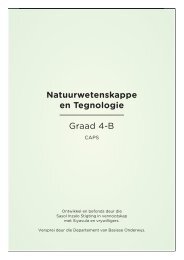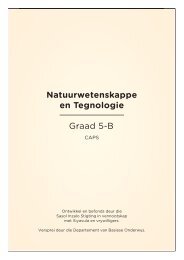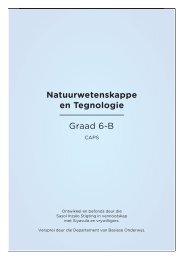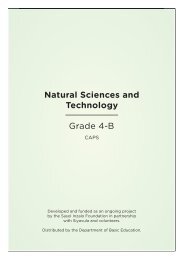Natural Sciences and Technology Grade 6-A - Thunderbolt Kids
Natural Sciences and Technology Grade 6-A - Thunderbolt Kids
Natural Sciences and Technology Grade 6-A - Thunderbolt Kids
You also want an ePaper? Increase the reach of your titles
YUMPU automatically turns print PDFs into web optimized ePapers that Google loves.
preserve it, just like people did 300 years ago, but there are many<br />
modern methods that are also used today.<br />
• sun drying<br />
• fermenting dairy into cheese, buttermilk (Amasi) or yogurt, or<br />
barley or grapes<br />
• pickling vegetables (onions or gherkins for example)<br />
• salting <strong>and</strong> spicing meet to preserve it (then drying it)<br />
• adding sugar to berries <strong>and</strong>/or fruit to make preserves<br />
• pasteurization: using just the right amount of heat to warm<br />
up milk or juice for example, to extend the shelflife<br />
• cooking: roasting, smoking, baking, frying<br />
• toasting<br />
• freezing or refrigerating<br />
• freeze drying<br />
• spray drying<br />
• making juice concentrates<br />
QUESTIONS<br />
When you go home from school today, make alist of the food<br />
products that you have at your house (whether they are in the<br />
cupboard, the fridge or the freezer). Next to each item, write<br />
down the type of processing it might have gone through, using<br />
the list above asaguideline.<br />
Chapter 4. Food processing<br />
DID YOU KNOW?<br />
The Ndebele people<br />
of southern Africa eat<br />
a plant called<br />
Umrorho. It is cooked<br />
or dried by spreading<br />
it out in the sun so<br />
that it can be stored<br />
for the cold winter<br />
months.<br />
67
















